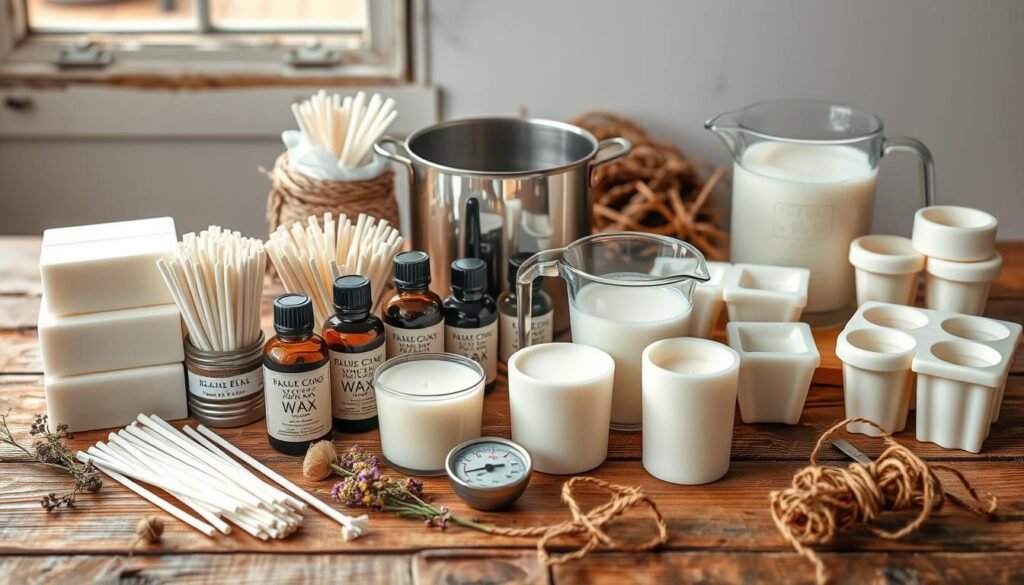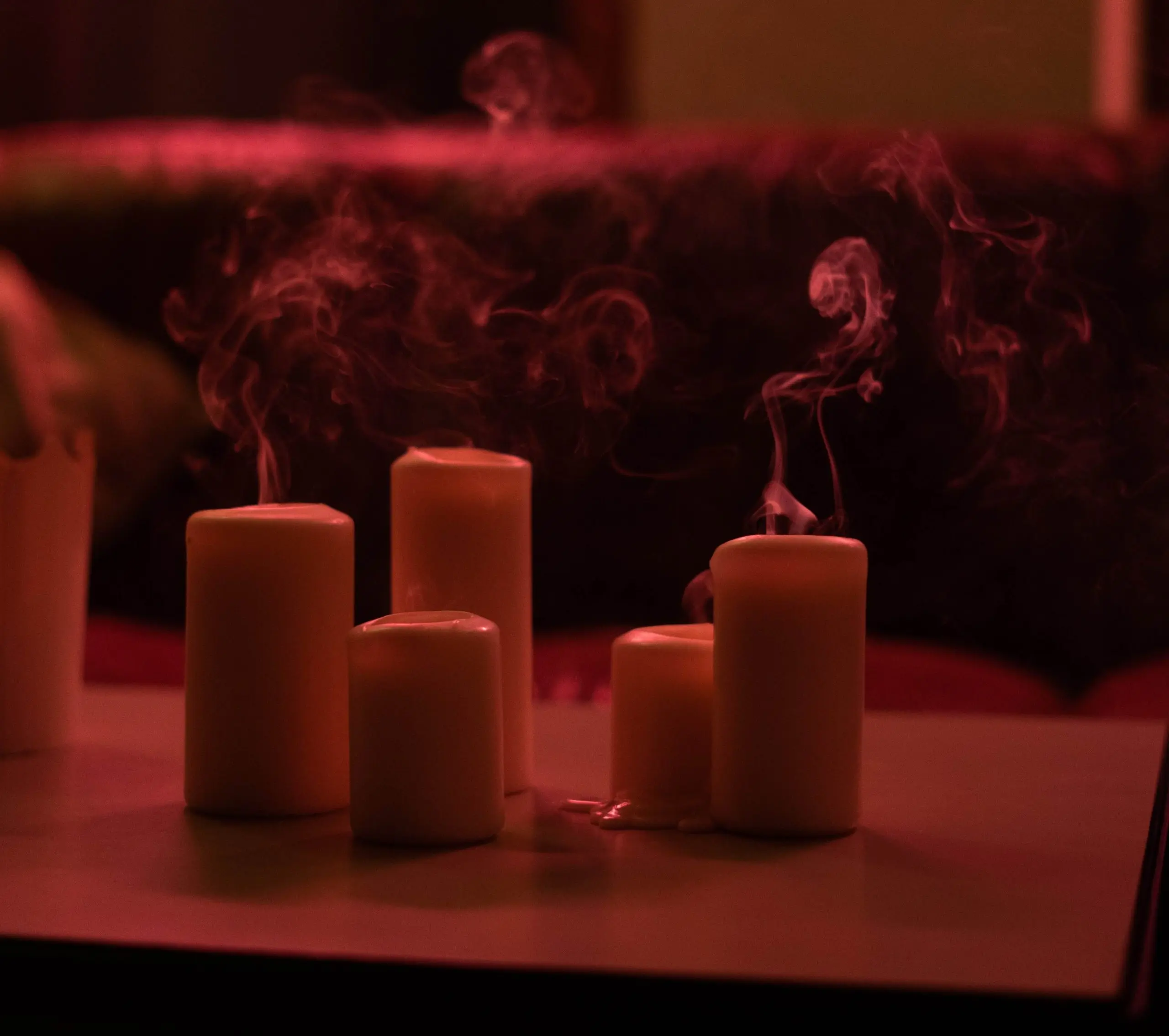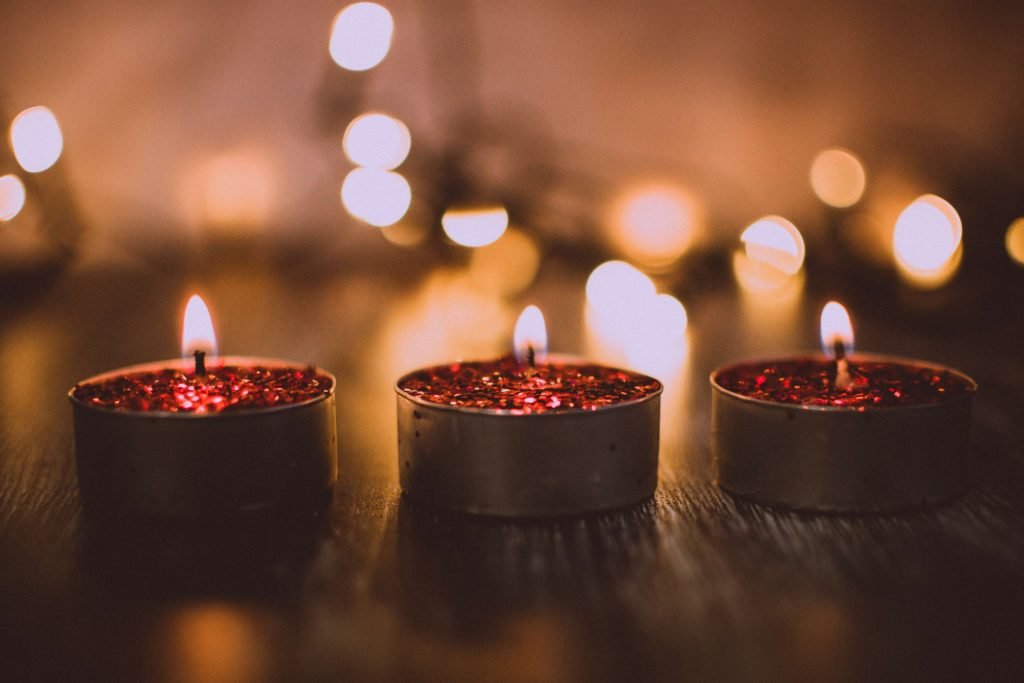Creating my own candles is magical. It’s like sculpting warmth and light. The flame’s soft flicker takes me to special places and brings back memories. It fills the air with my favorite scents.
Candle crafting is more than a hobby for me. It’s a ritual of love for my home and loved ones.
To start this journey, I need good candle making supplies. The ingredients I pick greatly affect the candle. The right wax and wick make my candles look good and smell great.
Whether I’m using a beginner kit or votive pins, every item is important. It makes my crafting experience better.
As I learn more, I look for guides on choosing the right wick. Knowing how to make candles means paying attention to details, especially wicks. Seeing my candles burn well is very rewarding.
If you’re curious about wick sizing, check out this guide on choosing the right wick for your candles.
Key Takeaways
- Candle making supplies include various wax types, wicks, tools, and additives.
- High-quality ingredients lead to better burning performance and scent throw.
- Understanding the properties of each wax type enhances the candle-making experience.
- Investing in suitable tools streamlines the candle crafting process.
- Testing and adjusting wick sizes can transform your candle’s functionality.
Understanding Candle Making Supplies
Candle making is really interesting. It starts with knowing the supplies. Choosing good ingredients is key. I pick the best wax, wicks, and scents for my candles.
The Importance of Quality Ingredients
Quality ingredients are very important. The wax you choose affects how long the candle burns and smells. Here are three waxes beginners often pick:
- Paraffin wax: It makes the candle smell better and burn longer.
- Soy wax: It melts easily, making candle making easier.
- Beeswax: It comes from bees and makes candles last longer.
Choosing the right wick is also key. Cotton wicks are common and versatile. Wood wicks make a cool crackling sound.
Overview of Essential Tools for Candle Making
For great candles, you need the right tools. My favorite tools are:
- A thermometer to check wax temperature.
- A double boiler for safe wax melting.
- A stirring tool, like a wood or silicone spoon, for mixing scents and dyes.
- Wick holders, like clothespins or chopsticks, to keep wicks straight.
- A wick trimmer for even burning.
For making candles, you can use glass jars, tins, or ceramic containers. Each one makes the candle unique. I love how all the parts come together.
Starting a candle business needs more supplies. You’ll need more wax, fragrance oils, containers, wicks, and tools. Plus, custom labels and packaging.
Candle making is a fun hobby that doesn’t cost much. You just need wax, wicks, and a pot. A good rule is to use 1 ounce of scent oil for every 1 pound of wax. This makes the candles smell great.
Knowing the melting points is important. Heat the wax to 185°F and cool it to 125°F before pouring. This makes the candles turn out well. I use a wick sticker or hot glue to keep the wick in place. This makes my candles look neat.
Candle Wax Types for Your Creations
Starting your candle-making journey means learning about different waxes. The wax you choose affects how well your candles burn and their impact on the environment. Let’s look at various waxes, their features, and benefits to find the best one for your projects.
Paraffin Wax vs. Soy Wax
Many makers choose paraffin wax for its low cost and good burn quality. It gives a steady flame and long burn time. But, it can harm the environment by releasing soot and harmful fumes.
Soy wax is better for the planet because it’s biodegradable and comes from a renewable source. It burns cleaner and holds fragrance well, making it great for eco-friendly candles.
Beeswax and Its Unique Properties
Beeswax is loved for its natural beauty and clean burn. It’s perfect for indoor use because it doesn’t pollute. Though pricier, its natural scent and look make it perfect for decoration.
Coconut and Palm Wax: What You Need to Know
Coconut wax is popular for its strong scent and clean burn. It’s made from coconut oil and is smokeless, making it great for air quality.
Palm wax has a unique look with beautiful patterns. It’s good for decorative candles but remember, palm oil production has environmental issues.
| Candle Wax Type | Key Benefits | Environmental Impact |
|---|---|---|
| Paraffin Wax | Cost-effective, even burn | Releases soot and harmful fumes |
| Soy Wax | Renewable, biodegradable, cleaner burn | Generally eco-friendly |
| Beeswax | Natural, sweet scent, no pollutants | Ethically sourced, but not vegan |
| Coconut Wax | Smokeless, excellent scent throw | Ethically produced |
| Palm Wax | Beautiful crystalline texture | Environmental concerns related to production |
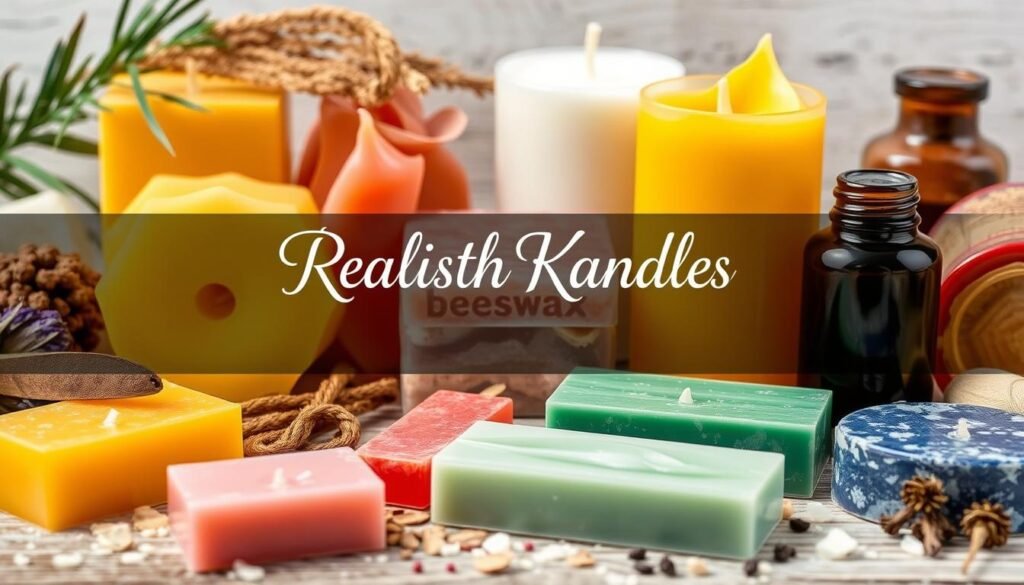
How to Make Candles: Step-by-Step Guide
Making candles at home is fun and rewarding. It lets you be creative and personal. First, you need to get the right supplies for candle making. There are three main waxes: paraffin, beeswax, and soy wax. Each has its own benefits.
Start by melting your wax in a double boiler or wax melter. Make sure it gets to the right temperature for pouring. The temperature needed varies based on the wax type.
| Wax Type | Melting Point | Cure Time |
|---|---|---|
| Paraffin Wax | 130-150°F | 2 days |
| Soy Wax | 120-140°F | 3-4 days |
| Beeswax | 145-155°F | Up to 10 days |
Then, prepare your wick. Make sure it fits right and is secure. You can use flat-braided or square-braided cotton wicks. When the wax is melted, add fragrance oils. Use about 6-10% of the wax weight for scent. Too little scent can make the candle smell weak.
After adding colorants, pour the wax into molds or containers. Use the right pouring techniques for a smooth finish. Let the candles cure properly. Soy wax takes about four hours to harden, but full curing is three to four days. Beeswax can take up to ten days.
Homemade candles can save money compared to store-bought ones. A pound of soy wax flakes costs $2 to $10. This makes three eight-ounce candles. You can try different scents and styles to make unique gifts or decor. For more details, see my guide on how to make candles.
Candle Wicking: Choosing the Right Wick
Choosing the right candle wicking is key for a great candle-making experience. Not all wicks work the same way. Knowing the different types can help you get the best results.
Think about the candle’s size and type. These things affect the wick size and stability you need.
Types of Wicks Available
There are many wicks for different candle uses. Here’s a quick look at some popular ones:
- Zinc core wicks: Great for votives, pillars, and small containers. Sizes are 44-24-18 for small, 51-32-18 for medium, and 60-44-18 for large.
- CD series wicks: Range from CD-4 to CD-22. They’re good for votives to large containers.
- ECO series wicks: Sizes from ECO-1 to ECO-14. They’re perfect for soy wax candles, from votives to large containers.
- HTP series wicks: Sizes from HTP-41 to HTP-1212. They’re for votives, small to large containers, with specific diameter needs.
- LX series wicks: Sizes LX-8 to LX-30. They’re great for small to large containers.
- Wooden wicks: Best for containers. Don’t use them in pillars or votives. They work with paraffin and soy wax.
Proper Wick Sizing and Stability
Getting the wick size right is crucial for good candle performance. A too-large wick burns too much, while a too-small one might not stay lit. The candle’s diameter is key to finding the right size.
Wider candles need larger or multiple smaller wicks for enough fuel.
The CandleScience Wick Guide is very helpful for finding a starting wick size. Always test wick sizes, as wax or fragrances can change burn rates. Keep an eye on the melt pool depth; it should be about 1/2 inch (13 mm).
For wick stability, make sure the wick is centered. Use wick stickum and centering devices to keep it in place. This prevents overheating or breaking the glass.
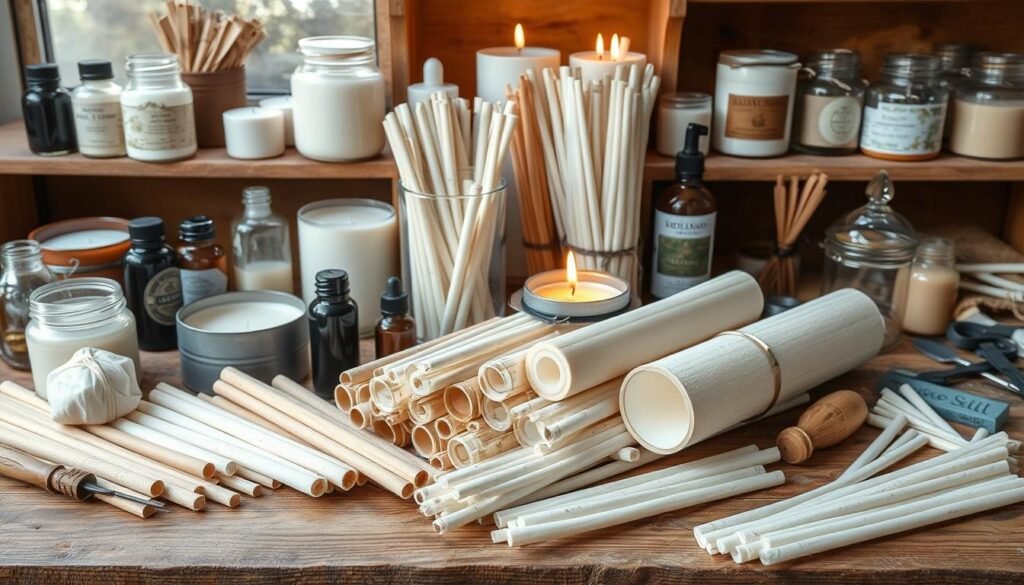
Additive Magic: Candle Scents and Dyes
Adding candle scents and colors makes my candles special. Choosing the right fragrance oils is key. They should match the wax type for the best smell.
Adding these scents at the right temperature is important. It makes sure the smell spreads evenly.
Choosing Fragrance Oils for Your Candles
Fragrance oils are crucial for my candles. I like to try different scents for different moods. This makes my candles special.
Studies show that color and scent should match. This helps create a better experience.
Using Colorants and Dyes Effectively
Colorants add beauty to my candles. I use liquid dyes for their bright colors and eco-friendliness. They come in many colors like Ebony and Scarlet.
Getting the right color is all about concentration. For deep colors, I use 0.05% dye. For lighter shades, it’s 0.005%. Testing small batches helps me get it right.
Food coloring is not good for candles because it’s water-based. It’s hard to mix and can be dangerous. I prefer candle dyes that are safe and eco-friendly. I’m excited to try new colors and scents in my next projects. I’ll use additive magic to make my candles stand out.
Conclusion
Candle making is a fun craft that lets me be creative and personal. I just need wax, wicks, and scents to make beautiful candles. These candles show off my style and bring joy to me and others.
I’ve found that using wax like beeswax and soy wax makes my candles special. Adding essential oils or fragrance oils takes them to the next level. Making a candle takes about 20 minutes, and it’s easy to do.
With just $20 to $30 for materials, it’s a hobby anyone can try. Following candle crafting tips helps me make candles that look great. I love making candles that make my home feel cozy and personal.
FAQ
What supplies do I need for candle making?
How do I choose the right wax for my candles?
What are the different types of wicks I should consider?
How do I make sure my candles burn evenly?
Can I use any fragrance oils for my candles?
What techniques should I follow when pouring wax?
How can I safely make candles at home?
What are some decorating ideas for my candles?
Source Links
- Candle Making Tools and Supplies
- The Ultimate Guide To Candle Making Supplies (For Beginners)
- 12 Essential Tools & Equipment For Candle Making
- The Ultimate Guide To Candle Making Supplies (For Beginners)
- How to Make Candles
- The 7 Types of Candle Wax: Benefits and Uses Explained
- 6 Different Types of Candle Waxes and Choosing the Right One
- How To Make Candles: 10 Simple Steps For Beginners (2024) – Shopify
- Easy DIY Candle Making at Home – Cutesy Crafts
- How to Make Candles: A Step-by-Step Guide
- Guide to Candle Wicks | How to Decide Which Wick To Use
- Choosing the Right Wick Size – Candle Making Guide
- Choosing the Right Type of Wick and Wick Size | Village Craft & Candle – Village Craft & Candle
- Color Your Candles With Vibrant Eco Candle Dyes
- The Artistry of Candle Making Colors: Hues and Waxes
- Simple DIY Homemade Candles for Beginners
- the ultimate candle making guide
- How to Make Candles: A Simple DIY Guide for Beginners
